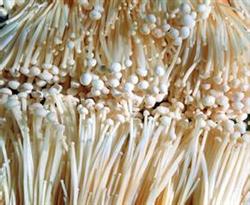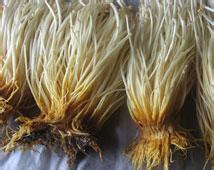New cultivation techniques of Flammulina velutipes with raw materials in greenhouse

The main results are as follows: 1. The fruiting bodies are clustered, the cap is 2-15 cm in diameter, hemispherical, the lid edge is rolled in, and then gradually unfolds in a flat shape. The stalk is straight, 2-13 cm long, 2-8 cm in diameter, nearly as thick as the top and bottom, solid at the initial stage and hollow at the later stage. There are two types of varieties, white and yellow, white is suitable for processing into bottled cans, yellow is suitable for fresh food and processed into dry products. Second, biological characteristics 1. The optimum temperature for mycelium growth was 16-28 ℃, and the optimum temperature was about 23 ℃. The mycelium stopped growing below 4 ℃ and over 34 ℃, and the mycelium died over 37 ℃. The forming temperature of fruiting body is 4: 24 ℃, the suitable temperature for growth is 5: 16 ℃, and the optimum temperature is about 13 ℃. two。 The suitable water content in the humidity material is 60%-70%, and the most suitable water content is 65%; the relative humidity of the air is required to be 60%-70% when germing. Mushroom production requires an appropriate relative humidity of 80% and 90%. The suitable pH of 3.pH is 6 to 7, and the optimum PH is 6.5. because the pH of raw meal decreases by about 0.5 after sterilization, the pH of raw meal is adjusted to 7.0. 4. Light hyphae do not need light, fruit bodies need scattered light, no light can not form fruit bodies. The light is too strong, the stalk is fat and short, the stipe tissue is fibrotic, the umbrella is opened early, and the stalk turns brown, which reduces the commercial value. 5. Flammulina velutipes in the air is carbon dioxide resistant, such as fresh and adequate oxygen, hyphae and fruiting bodies develop well; when the concentration of carbon dioxide exceeds 1%, the stalk is slender and needle mushrooms appear; when the concentration of carbon dioxide reaches 5%, the fruiting body cannot be formed. 6. Nutritious Flammulina velutipes belongs to wood-rotten type, and the optimum ratio of carbon to nitrogen is 20 ∶ 1. Third, strain production 1. The optimum culture medium for mother seed is as follows: ① water 1000 ml, potato (peeled) 200g, sucrose 20g, potassium dihydrogen phosphate 0.6g, magnesium sulfate 0.5g, Agar amount; ② water 1000 ml, glucose 30g, peptone 2g, potassium dihydrogen phosphate 0.6g, magnesium sulfate 0.5g, vitamin B1 0.1g, Agar 20g ③ water 1000 ml, rice straw (boiled juice) 200g, sucrose 3g, ammonium sulfate 3g, Agar 20g. two。 The optimum formula for original and cultivated species: ① broad-leaved tree sawdust 73%, organic matter (wheat bran, rice bran, corn meal or soybean cake powder) 25%, gypsum 1%, sucrose 1%; ② cottonseed hull 88%, wheat bran 10%, sucrose 1%, gypsum 1%; ③ wheat kernels (or corn kernels) 99%, gypsum 1%. Dry material ∶ water = 10 ∶ 12: 13. The mother species grew full in 10 days, and the mother original species and cultivated species grew full in about 30 days. Seed production is carried out according to routine operation. Fourth, cultivation 1. The cultivation material formula ① cottonseed 85%, wheat bran 13%, gypsum 1%, calcium carbonate 1%. ② sawdust 77%, wheat bran (or corn meal, rice bran, soybean cake powder) 20%, sucrose 1%, gypsum 1%, calcium carbonate 1%. two。 Preparation of fermentation materials ① mix main materials such as cottonseed shell, organic matter, sawdust and water-insoluble accessories, such as gypsum and calcium carbonate, mix evenly when dry, sprinkle water-soluble excipients such as sucrose in water, and then pour water to mix evenly. The ② stack is 1mm to 1.5m wide and 1.2m high, depending on the number of materials and the site. The width difference between the upper and lower pile is not more than 20 cm. The surface is covered with straw curtain to keep warm and moisturizing. ③ turned the pile 2 times 3 times, 20 centimeters from the surface temperature reached 60 ℃ to start the clock, maintain 48 hours, and then turn the pile. Turn the pile principle: turn up and down, turn in and out. After the material temperature reaches 60 ℃, it is best to turn the pile again for 48 hours. The standard ④ high-quality material is full of white feathery hyphae and special bread flavor, which is high-quality material and can not be moldy or smelly. Spray 0.1%-0.2% carbendazim after fermentation. 3. Smoked once 3-4 days before feeding: formaldehyde 5ml / m3, sulfur 15g / m3 or aerosol 3g / m3; fumigation again after feeding, and timely ventilation. 4. The width of the seeding bed is 80 cm 100 cm and the thickness of the material is 15 cm 17 cm. Before sowing, the ground is sprayed with insecticides and fungicides, while laying the material, slightly compacting at the same time, with 2 layers of bacteria, one layer in the middle and one layer on the top, the amount of bacteria is 10% to 15% of the dry material, the middle is 2%, and the surface and the surroundings are 3. 5. After sowing, sprinkle a thin layer of material on the surface, then cover it with a straw curtain, spray carbendazim, and then seal it with plastic film. 5. The temperature of germ management is controlled at about 23 ℃, the relative humidity of the air is controlled at 60%-70%, the shed is often ventilated, and the plastic film on the material surface is shaken once every morning and evening for ventilation. The mycelium grows full in about 30 days, and it is gray to reach physiological maturity. 6. The neatness of buds is the key to obtain high yield and high quality. First of all, the temperature should be controlled at about 13 ℃, it is difficult to produce mushrooms below 8 ℃, and the fruiting body above 18 ℃ is sparse. Humidity should be controlled at 90%. At the same time, the film should be exposed and ventilated for 10 minutes every day to change the hyphae from gray to snow white, and brown droplets will appear to produce buds. 7. Measures for promoting production after budding in order to eliminate the apical dominance of Flammulina velutipes and promote the potential lateral bud tillers on the stalk to regenerate a large number of buds, in order to obtain more fruiting bodies and achieve the purpose of increasing production, the following measures can be taken: ① ventilation drying wilting method (that is, regeneration method), when the mushroom grows to 2-3 cm, the film is exposed, ventilation and drying, so that the cover wilts, and the stalk still has a certain hardness, begin to cover the film and support it. After giving it to the right temperature and humidity, dense buds appeared in about 4 days. ② when the mushroom grows to about 3 cm, cut off the mushroom tip and cap, press the stalk on the bacterial bed, give it to the appropriate temperature and humidity, and increase the concentration of carbon dioxide, and dense buds also appear in about 4 days. 8. The harvest standard of harvesting fruiting body: the handle length is 10 cm to 15 cm for export and 25 cm for domestic sale, and the cover cannot be opened. Hold down the fungus bed with one hand during harvest and gently pull out the mushroom body with the other. Then pick up the residual mushrooms, cover the film, and wait for the mycelium to restore growth, then the secondary production of mushrooms can be carried out. Pay attention to the problem 1. The causes of abnormal phenomena are ① cap adhesion, Tribulus terrestris, Pleurotus ostreatus, etc., which are caused by insect pests. ② black spots and soft rot are caused by mold. ③ rust and brown rot are caused by bacteria. ④ arbuscular branches (only long stalks, no cap or very small cap): caused by high carbon dioxide concentration or excessive humidity. The ⑤ culture material is wet-rotten and black-brown, which is caused by nematodes. Milky white, grayish white, yellowish or pink sticky matter occurred on the surface of ⑥ culture material, which was caused by myxobacteria. two。 The measure of promoting production is the key to increase the yield, but this measure is limited to the first tide mushroom, the second tide mushroom and the third tide mushroom. 3. The fermentation material must meet the maturity standard, and this measure is the key to the success of cultivation. 4. Maintain regular hygiene in the shed, clean up residual and diseased mushrooms in time, and often spray fungicides and pesticides, especially fungicides.
- Prev

"five measures" for effective control of blackhead disease of Flammulina velutipes
Blackhead disease, also known as bacterial brown spot, is a kind of pseudomonas, belonging to the phylum and class of fission bacteria. The bacteria were rod-shaped, forming white colonies and negative for Gram staining. 1. The internal cause of the disease is the non-resistance of the variety, and the external cause is high temperature, high humidity or unclean spraying.
- Next

Control methods of root rot of Flammulina velutipes
The basic rot of Flammulina velutipes is also called root rot, which mostly occurs in Flammulina velutipes cultivated with raw materials, but it is also common in clinker cultivation and bottle cultivation in recent years, and the harm is more serious. Symptoms: in the early stage of the disease, waterlogged spots occurred at the base of the stalk, which gradually expanded and deepened with the development of the disease.
Related
- Fuxing push coffee new agricultural production and marketing class: lack of small-scale processing plants
- Jujube rice field leisure farm deep ploughing Yilan for five years to create a space for organic food and play
- Nongyu Farm-A trial of organic papaya for brave women with advanced technology
- Four points for attention in the prevention and control of diseases and insect pests of edible fungi
- How to add nutrient solution to Edible Fungi
- Is there any good way to control edible fungus mites?
- Open Inoculation Technology of Edible Fungi
- Is there any clever way to use fertilizer for edible fungus in winter?
- What agents are used to kill the pathogens of edible fungi in the mushroom shed?
- Rapid drying of Edible Fungi

